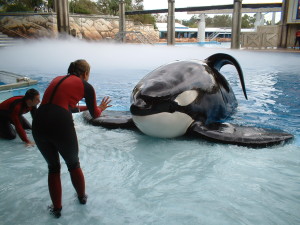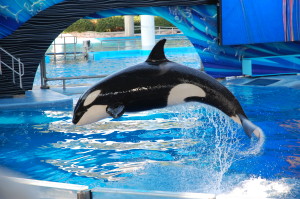SeaWorld Drowning
Posted: April 21, 2015, 3:10 p.m.
by Ana Vega.
It’s been nearly two years since the “Blackfish” documentary was released that tore apart SeaWorld’s image. But that isn’t the only PR disaster the entertainment company has faced within its 56 years of existence. With incidents from whale fighting during a live show (1989), nearly drowning a trainer (2006) and its most recent disaster of killing a trainer, Dawn Brancheau, I believe it’s safe to say that maybe Willy wasn’t the only one that should have been freed.
But then again, who’s to say that all whales are dangerous? Or is it the trainers who are the dangerous ones? “Blackfish” dove further into the harsh treatment of SeaWorld’s animals and said that the reason for the whales lashing out isn’t because they are dangerous creatures, but because of how they are treated.
 The results from the documentary were pretty harsh to say the least. Multiple top artists, including Martina McBride, Willie Nelson and more, cancelled their shows that were to be held at the theme park, which left SeaWorld’s stock down 50 percent from the previous year. Of course, the company denied the accuracy of the film, but that didn’t stop the decrease in attendance.
The results from the documentary were pretty harsh to say the least. Multiple top artists, including Martina McBride, Willie Nelson and more, cancelled their shows that were to be held at the theme park, which left SeaWorld’s stock down 50 percent from the previous year. Of course, the company denied the accuracy of the film, but that didn’t stop the decrease in attendance.
Now fast forward to 2015, and SeaWorld is still trying to come back from that disaster. The goal of the new “SeaWorld Cares: You Ask, We Answer” campaign is for the public to ask tough questions and receive a truthful response. The company is using Twitter as a main portal to show its transparency. With the hashtag #AskSeaWorld tracking questions, the company will later answer them on the AskSeaWorld.com website.
 OK . . . that plan didn’t go over so well. As PR professionals, we all know that the public is willing to make a joke out of anything, including a basic hashtag. But don’t you worry — SeaWorld struck back by responding to negative remarks with name calling and referring to them as “trolls.” Good one, SeaWorld.
OK . . . that plan didn’t go over so well. As PR professionals, we all know that the public is willing to make a joke out of anything, including a basic hashtag. But don’t you worry — SeaWorld struck back by responding to negative remarks with name calling and referring to them as “trolls.” Good one, SeaWorld.
Not to mention, the Twitter chat hasn’t exactly helped the park make friends. In fact, the campaign has resurfaced the anger of many people who aren’t afraid to let SeaWorld know how they feel.
“Why do you LIE & tell guests collapsed dorsal fins are normal when only 1% suffer this in the wild?” PETA asked via Twitter. And not surprisingly, SeaWorld did not respond.
The company has been blasted by hundreds of tweets similar to the one above since this attempt to clean up its image began. I’m sorry, SeaWorld, but it looks like the roles have reversed, and you’re the one that is tanked now.
Opinions
Comments are closed.





Post comment
I haven’t seen “Blackfish,” and I used to not mind the use of animals in shows. However, recently a post appeared on my Facebook feed that forever changed my opinion about animal shows.
The article focused on the life of an orca named Hugo who performed for 12 years at Miami Seaquarium. During those 12 years, Hugo regularly and intentionally bashed his head and other parts of his body into the sides of his tiny tank. One time he rammed into the wall so hard, he caused a gash that had to be sewed up by a veterinarian. Another time, he died.
Orcas are incredibly intelligent creatures. They are smart enough to learn entire performance routines and they have good memories. It is very likely that Hugo had memories of his life in the ocean. Hugo wanted out, and after 12 years, with one last bang against the plexiglass wall, he killed himself in what many agree was a suicide attempt. It was his only way out.
Miami Seaquarium has tried to pretend Hugo never existed. There are no signs commemorating him or his 12 years of service to the park, and when Hugo died, the organization dumped his remains into a local landfill.
After 45 years in captivity, Lolita, a female orca who was intended to be a mate for Hugo, is still in the “world’s smallest orca tank” at Miami Seaquarium. She hasn’t had any contact with other orcas since Hugo died in 1980.
It is too late for Hugo, but we can save Lolita and other orcas living as slaves to entertainment. It is time to stand up to organizations like Sea World and Miami Seaquarium. We cannot let movies like Blackfish and articles on Facebook be a temporary push for animal activists only to forget about them when the movie is over or we scroll past the post. We must put real pressure on these organizations. We must stop visiting their shows, write our legislators and advocate for these animals. They cannot fight for themselves. Without us, there is only one way out. Let’s give them another option and release them into the open waters.
httpss://dolphinproject.net/blog/post/one-dolphins-story-hugo/
Permalinkhttpss://www.thedodo.com/lolita-orca-45-years-1301583008.html
Post comment
After watching Blackfish I was interested to see how Sea World was effected by this documentary. Personally, I was horrified to see how the whales were treated while in captivity. These wild animals deserve to live a free life. I was even more shocked to see how Sea World responded publicly when trainers were injured or killed by the whales. The company did everything in their power to blame the trainers for the accidents in order to keep the whales at Sea World. I hope the company continues to receive scrutiny and loses credibility as a company.
PermalinkPost comment
This whole situation is just a total PR nightmare. It seems to me that if SeaWorld was really adamant about fixing their image then they would be taking action instead of just talking about it. People will believe anything they hear and right now SeaWorld is up against a large group of people who have heard that SeaWorld is responsible for the harsh treatment of their animals. I guess SeaWorld responding with the “question and answer” tactic was a good idea in theory, but if you’re not willing to answer ALL the questions being asked then what’s the point? It’s like they are taking one step forward and two steps back.
Permalink